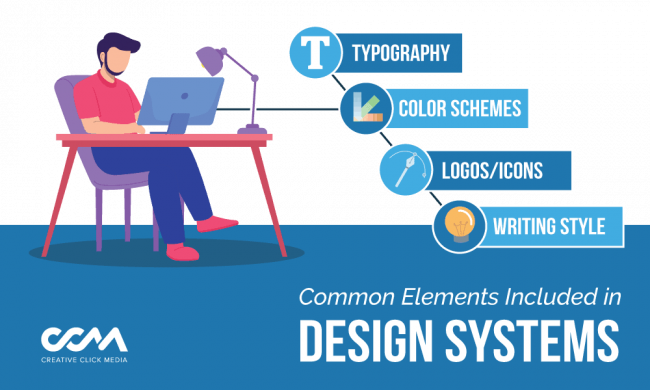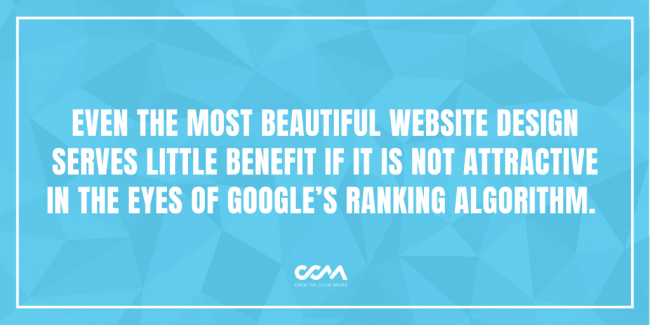You might love your company’s website right now, but that fresh new design probably won’t look so fresh and new after a few years. At least redesigning your website is a pretty straightforward fix, right? Well, not exactly. From an SEO perspective, your website needs more than a cool design and compelling copy to drive traffic and convert visitors into customers. While they’re both important elements of your redesign, the true secret ingredient to success is a stellar user experience. That’s where design systems come into play.
What Are Design Systems?
A design system is a series of design components, language guidelines and other digital assets that act as the instruction manual for your company’s branding. Ideally, these elements will remain relatively consistent no matter how many times you redesign your website. Your design system may be only a small snippet of who your company is, but it’s critical to the grander scale of your new website’s development.
Some common elements seen in design systems include:
- Typography
- Color Schemes
- Slogans
- Writing Style
- Product/Service Categories
- Source Files
- Logos/Icons
- Templates
The purpose of having a design system in place is to ensure that everyone who works on a website’s redesign is on the same page with the way things should look, read and be implemented. It also helps to ensure the core of your company is not lost when you change the style of your website, no matter how different the design may be. Even if the look of your landing page is completely different, having these key elements helps to keep your brand recognizable.
As an added bonus, design systems can also speed up the time it takes to redesign your website. This is especially true if multiple designers or departments will have a hand in your redesign. Having a design system in place ensures the most critical assets of your branding can be accessed by each department without having to track down or replicate any elements that may have been lost or forgotten in the shuffle.
 How do Design Systems Impact SEO?
How do Design Systems Impact SEO?
If you notice your SEO is slipping, your first instinct might be to assess your website’s visual downfalls. Is your design just not appealing anymore? Are your blogs not interesting to your readers? While these could be true, a drop in SEO is often a sign of something more significant beneath the surface. Instead of thinking about the way your visitors view your website, think about how they interact with it.
We often think about SEO in terms of picking the perfect keywords and writing captivating content, but neither of those serve much benefit if your website’s user experience (UX) drives visitors away. Think about it this way: how often would you go to the mall if the layout was a maze and there was no directory to help you find the store you came for?
Having a design system in place acts as that directory – first for your designers, then for your customers. It provides your team with the materials they need to create a familiar user experience by carrying over the elements from your previous design that made your brand recognizable. It also helps to ensure that your UX is consistent from desktop to mobile and any other device in between.
An organized and familiar layout that functions well across devices will engage your visitors and keep them on your website longer. This then signals to search engines that your website is meeting the needs of their users. The result? An SEO boost.
When Should You Redesign Your Website?
Now that we’ve covered why design systems are important to have in place before overhauling your website, one big question remains: how do you know when it’s time for a redesign?
Your website doesn’t come with an expiration date, so there’s no definitive way of knowing when it’s past its prime. However, there are signs you can look for that will indicate when a refresher is needed:
Your UX is Suffering: A positive user experience is the single most important element of your website’s design. If you notice your website’s interface isn’t exactly user friendly – or worse, a customer tells you it isn’t – something in your design needs to change. Having a design system on hand will make it much easier for you to keep UX at the forefront of your website overhaul.
It’s Been Over 2 Years: The average lifespan for a website design is somewhere between 2 and 5 years. With advancements in technology and digital marketing best practices changing faster than ever, that benchmark is actually inching closer to 2 and 3 years. As a general rule of thumb, 2 years is about when you should start assessing whether or not a website redesign will be necessary in the near future.
It Looks Outdated: Keep an eye on websites from your competitors and leaders in your industry. How does your design stack up? If you notice yours looks outdated in comparison, it’s probably time for a refresh if you want to maintain a competitive edge.
You Aren’t Generating Leads Anymore: The lead generation tactics you employed while designing your website years ago may not be as effective today. For example, elements like pop ups that were popular years ago are often seen as disruptive to your UX by current standards. Your website should be your most effective tool for converting visitors into customers. When leads stop rolling in, it’s a telltale sign that something in your website’s design is no longer working.
 How Can You Redesign With SEO in Mind?
How Can You Redesign With SEO in Mind?
First and foremost, no redesign should be attempted without having SEO at the forefront of your mind at all times. Even the most beautiful website design serves little benefit if it is not attractive in the eyes of Google’s ranking algorithm. Here are a few ways you can utilize a design system to create a SEO-focused redesign that converts:
Be Consistent: If you’ve ever visited a company’s website after a massive overhaul, you know how confusing it can be when their design is unrecognizable. You might even convince yourself that you clicked on the wrong website and abandon the page entirely. When visitors leave your website after viewing only one page, it increases your bounce rate which can decrease your SERP ranking. Having a design system in place will ensure critical elements like your logo, color scheme and brand voice stay consistent, no matter how many times the design itself changes.
Optimize for Mobile Browsing: Over 90% of the global population browses the internet on a mobile device. Naturally, this means your UX hinges on creating a design that’s both beautiful and functional on any size screen. Fail to cater to the mobile-first market, and you’ll isolate potential customers and search engines alike. Luckily, the graphic and technical components included in design systems will help you create a responsive design that looks and functions the same from any device.
Understand Industry Trends: While your design system should align with the core of your company’s branding, the actual design of your website should align with the latest trends in your industry. Keep an eye on your competitors’ websites along with Google algorithm updates to ensure you are on the pulse of the web design trends you should be keeping up with. The industry standard today could be virtually obsolete overnight, so it’s important to check this regularly. Fail to do so and you could turn off potential customers and tank your ranking.
Keep it Simple: When it comes to UX design, less is often more. As tempting as it might be to load up your new website with as many colors, graphics and plugins as you can fit on your screen, you’ll find that your design can quickly look cluttered and chaotic. A busy website might also take longer to load, which could be a bad sign for your SEO. Pair down your design system to include only your must-have branding elements, and ensure that your redesign highlights them rather than overshadows them.
 Ready for a Redesign?
Ready for a Redesign?
Now that we’ve covered the basics of design systems and how they relate to your UX and SEO, the next step is to get started on your website’s redesign. If you’ve made it this far, you know by now that effectively overhauling your website is so much more than a cool new design – you need to also consider how it’ll function, how your customers will interact with it, and how search engines will index it.
Not sure where to start? Don’t worry – we’ve got you covered. Creative Click Media’s team of talented web designers and SEO experts are well-versed in the ins and outs of creating beautiful websites with user experience at the forefront. Most importantly, they’ll work closely with you and your team to ensure your unique design system perfectly captures the essence of your brand. A striking new website that drives traffic and generates leads is only a click away – contact us to get started.




